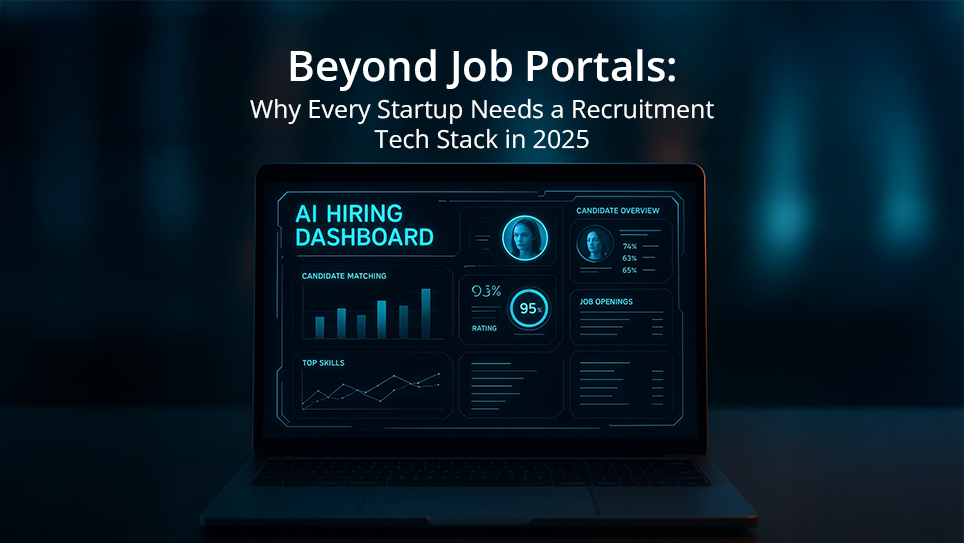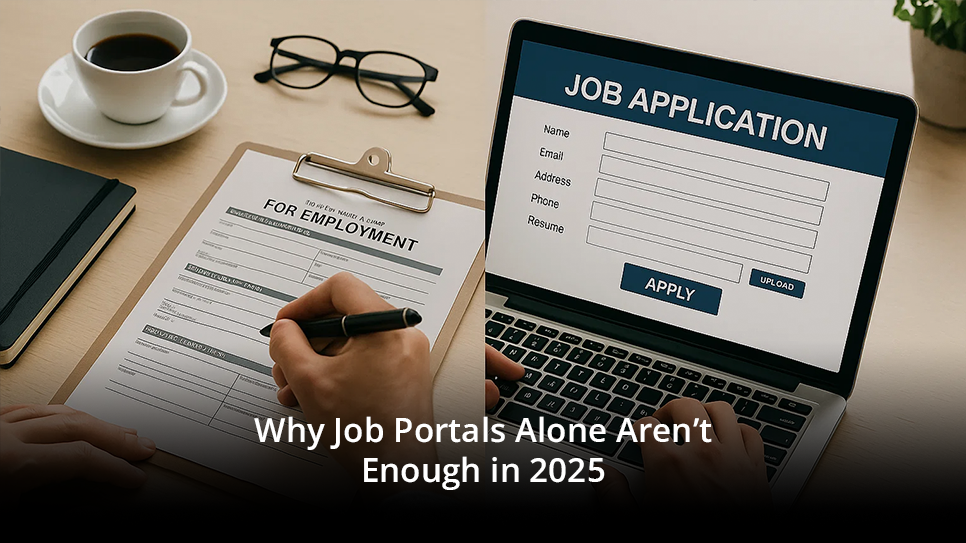Beyond Job Portals: Why Every Startup Needs a Recruitment Tech Stack in 2025

Every startup knows how crucial it is to hire the right people, but if your hiring strategy begins and ends with posting on job boards, you could be falling behind. In 2025’s ultra-competitive talent market, relying solely on traditional job portals is not enough. Forward-thinking startups are assembling a recruitment tech stack (also known as a recruitment technology stack) to supercharge their hiring. This integrated set of modern hiring tools and platforms goes beyond job postings, helping companies find and onboard talent faster and smarter.
Why the shift? A comprehensive recruitment technology stack offers capabilities that a single job portal can’t match. From generative AI in recruitment (automated resume screening and chatbot assistants) to analytics dashboards that track every hiring metric, these tools give startups an edge. Using such a stack means less time lost on manual tasks and more time engaging with quality candidates. In short, every startup needs a recruitment tech stack in 2025, not just job portals.
In this blog, we’ll explore why having a dedicated recruitment tech stack is no longer a luxury but a necessity. You’ll learn what goes into a recruitment tech stack, why job boards alone aren’t enough, and how embracing modern solutions can transform your hiring process.
What You’ll Learn in This Blog
- What a Recruitment Tech Stack Is: Understand the components of a modern recruitment technology stack (ATS, CRM, recruitment automation tools, etc.) and how it goes beyond basic job portals.
- Why Job Portals Aren’t Enough: Discover the limitations of relying only on job portals for hiring and why startups need more sophisticated modern hiring platforms to compete in 2025.
- Key Benefits for Startups: Learn how an integrated tech stack streamlines hiring, from saving time through automation to improving candidate quality and experience, with real-world insights.
- Future-Proofing Recruitment: See how embracing new trends (like generative AI in recruitment) keeps your hiring agile as you grow.
What is a Recruitment Tech Stack?
A recruitment tech stack (or recruitment technology stack) is the collection of digital tools, platforms, and software that a company uses to manage its hiring process from end to end. Think of it as the hiring equivalent of a startup’s product tech stack, but instead of programming frameworks, it’s made up of hiring solutions. This can include an Applicant Tracking System (ATS) for tracking candidates, a Candidate Relationship Management (CRM) tool for nurturing candidate leads, recruitment automation tools for tasks like interview scheduling or resume screening, assessment platforms for testing skills, and more.
In essence, your recruitment tech stack combines multiple tools into one cohesive system for talent acquisition. A job portal might be one component, a source of incoming applicants, but the stack doesn’t stop there. For example, you might source passive candidates on LinkedIn, use an AI-driven screening tool to filter resumes, and rely on scheduling software to set up interviews automatically. When these pieces integrate and “talk” to each other, they create a powerful pipeline that moves candidates smoothly from application to offer.
By contrast, relying on a single job board or manual process is like trying to build a complex product with just one tool; it’s not sufficient. A full stack ensures every step of hiring is supported by technology, which is especially crucial for startups that need to hire effectively with limited HR resources. As FX31 Labs notes in its talent solutions, platforms like Talent31 use AI algorithms to deliver top global developers aligned with your tech stack needs. This kind of capability is only possible when you leverage a full tech stack of recruitment tools rather than just posting on portals and hoping for the best.
Why Job Portals Alone Aren’t Enough in 2025

Job portals (like generic job boards or career sites) have been useful for years, but in 2025, they’re only one piece of the talent acquisition puzzle. Here are some reasons why portals by themselves fall short, and why startups need more:
- Limited Reach to Top Talent: The best candidates, especially in tech, aren’t always scouring job boards. Many top people are passive candidates found on LinkedIn, GitHub, or niche communities. Relying only on portals means you miss out on these passive stars. A proactive sourcing approach (often via AI-driven tools) is needed to engage talent beyond those actively applying on portals.
- Slow, Manual Processes: Posting jobs and waiting is painfully slow. Sorting through hundreds of resumes by hand and coordinating interviews over email wastes precious time. In a startup, speed is everything. Without automation, your team could spend weeks on tasks that recruitment automation tools can do in minutes. For instance, AI-based screeners and chatbots can quickly filter out unqualified applicants and answer common candidate questions, accelerating the hiring cycle.
- Poor Candidate Experience: Top candidates expect a fast, smooth hiring process. If candidates apply via a portal but then hear nothing for weeks, they’ll lose interest or form a bad impression of your startup. A tech stack helps avoid this by using tools like a CRM for timely follow-ups, automated interview schedulers (no more back-and-forth emails), and personalized communication at scale. The result is a better experience that keeps quality candidates engaged and interested in your company.
- Lack of Data and Insights: Job boards alone provide very little visibility into your hiring funnel. You might see how many people applied, but do you know where candidates drop out or which sources yield the best hires? Probably not if you’re only using basic portals. In contrast, an integrated recruitment technology stack gives you analytics at each stage, from application rates to interview performance, enabling data-driven decisions. Startups thrive on metrics, and hiring should be no exception. With the analytics from a connected stack, you can continually optimize your recruitment strategy.
Benefits of a Recruitment Tech Stack for Startups

Adopting a full recruitment tech stack (complete with modern recruitment automation tools) offers startups several advantages:
- Hire Faster and Smarter: Startups often operate on tight timelines, and you need that developer or marketing lead yesterday. A recruitment tech stack dramatically increases hiring speed through automation and better organization. Time-consuming tasks like screening resumes, scheduling interviews, or sending follow-up emails are handled by recruitment automation tools, freeing your team to focus on high-value interactions. This cuts your time-to-hire significantly (companies using modern tech see hiring cycles shorten by up to 60%) and also improves quality by filtering out mismatched candidates early.
- Improve Candidate Quality and Fit: With the right tools (such as AI sourcing and skill assessments), you can greatly improve the caliber of applicants and eventual hires. Instead of hoping the right person finds your job ad, you proactively target ideal profiles and objectively vet their skills. Over time, data from your tech stack reveals which sources and methods produce the best hires, allowing you to continuously refine your strategy. The result is new hires who ramp up faster and stick around longer.
- Enhanced Candidate Experience and Brand: A well-managed, tech-enabled process makes candidates feel valued. From prompt, personalized communications to easy interview scheduling and quick feedback, your tech stack helps ensure a smooth journey for applicants. Even candidates who don’t get hired will remember a smooth process, boosting your reputation and employer brand. Delivering a modern, efficient experience shows that your startup is agile and respectful of candidates’ time, which can set you apart in a crowded job market.
- Scalability and Flexibility: A strong recruitment tech stack also makes it easy to scale your hiring. Whether you suddenly need to hire ten people instead of one, or you’re expanding into new roles and regions, your system can handle the load. The stack’s flexibility means you’re not locked into one way of recruiting; it works whether you’re growing an in-house team, leveraging startup engineering services to augment your team, or coordinating a mix of in-house staff and dedicated tech teams for startups. You maintain control and organization as you scale, instead of letting chaos creep in.
All these benefits ultimately give startups a competitive edge in the talent wars. It’s not just theory, either; companies that embrace modern recruiting software see real results. For example, 75% of recruiters use an ATS or similar tech tool to review applicants, and 94% say it has improved their hiring process. Meanwhile, only about 20% of small businesses use an ATS, so startups that adopt a tech stack early can leap ahead. Embracing innovations (nearly 37% of organizations are already experimenting with generative AI in hiring) can further boost efficiency. In short, leveraging technology in recruitment isn’t just nice to have; it’s becoming the baseline for success.
Conclusion
In 2025, hiring isn’t just a function. It’s a competitive edge.
The startups that win aren’t just posting jobs, they’re building intelligent recruitment systems. Stacks that combine automation, AI, and real-time visibility to scale fast without losing precision.
At FX31 Labs, we’ve seen this firsthand. We’ve helped global companies scale from zero to 50+ engineers in under six months – not just quickly, but with structure, clarity, and long-term scalability.
It goes beyond just hiring. We help build global in-house centers that drive innovation and product velocity. Whether it’s:
- Custom enterprise app development
- Generative AI integration
- Full-stack engineering across backend, frontend, and cloud
- Process alignment across people and platforms
We make it all work, fast.
And with Talent31, our intelligent hiring platform, you can discover, assess, and onboard the right talent globally. Built for startups ready to scale with speed, not chaos.
The future of hiring isn’t coming. It’s already here.
Are you still posting, or are you building your tech stack?
Ready to scale smart? Let’s talk.
FAQs
1. What is a recruitment tech stack for startups?
A recruitment tech stack is a collection of digital tools and platforms that streamline the hiring process. For startups, it includes systems like ATS (Applicant Tracking System), CRMs for candidate nurturing, recruitment automation tools, assessment software, and AI-based sourcing tools. Together, these tools create a faster, smarter, and more scalable hiring pipeline.
2. Why are job portals not enough for hiring in 2025?
Job portals alone reach only active job seekers. In 2025, the best talent often isn’t actively looking. Portals also lack automation, data visibility, and candidate engagement tools. A recruitment tech stack fills these gaps by enabling proactive sourcing, fast communication, and real-time hiring insights
3. How does a recruitment tech stack improve candidate experience?
Candidates today expect a smooth, fast, and personalized hiring experience. A tech stack enables this through tools like automated interview schedulers, real-time updates via CRM, and AI chatbots. These tools reduce delays, increase transparency, and help candidates feel value, even if they’re not selected.
4. Can a startup afford a recruitment tech stack?
Yes. Many recruitment tools now offer startup-friendly pricing or modular plans. The ROI is often immediate, by reducing time-to-hire, improving candidate fit, and freeing up internal resources. Startups that invest early in a tech stack scale faster without compromising on quality.
5. How does Talent31 fit into a recruitment tech stack?
Talent31 is an AI-powered hiring platform built to help startups scale their teams quickly and strategically. It integrates seamlessly into your hiring stack, offering global talent discovery, smart assessments, and streamlined onboarding. Talent31 focuses on speed without sacrificing candidate quality.
